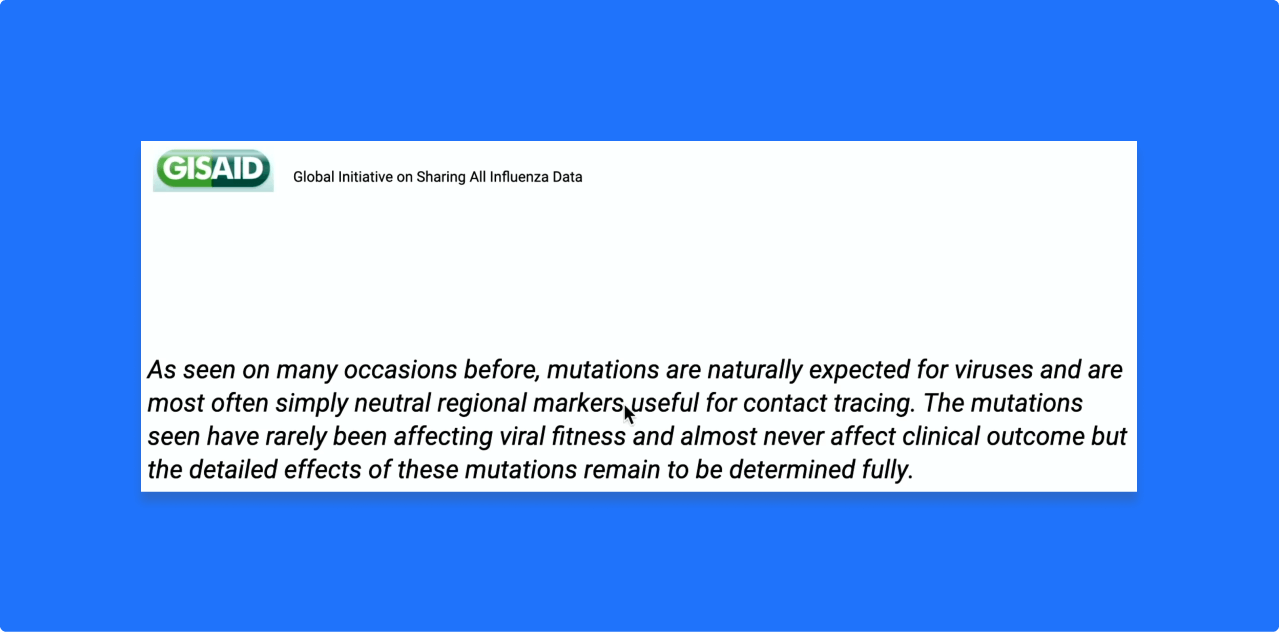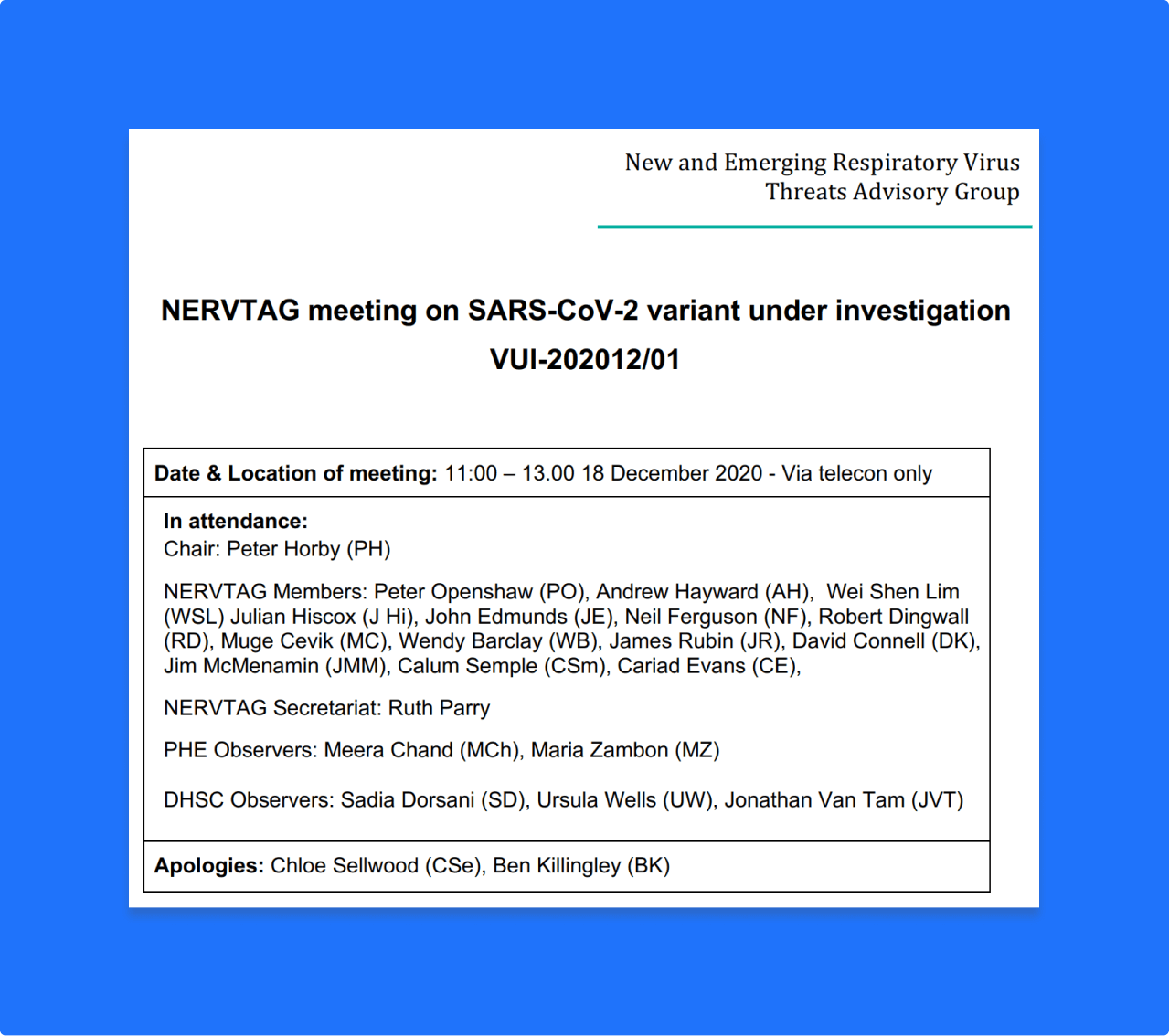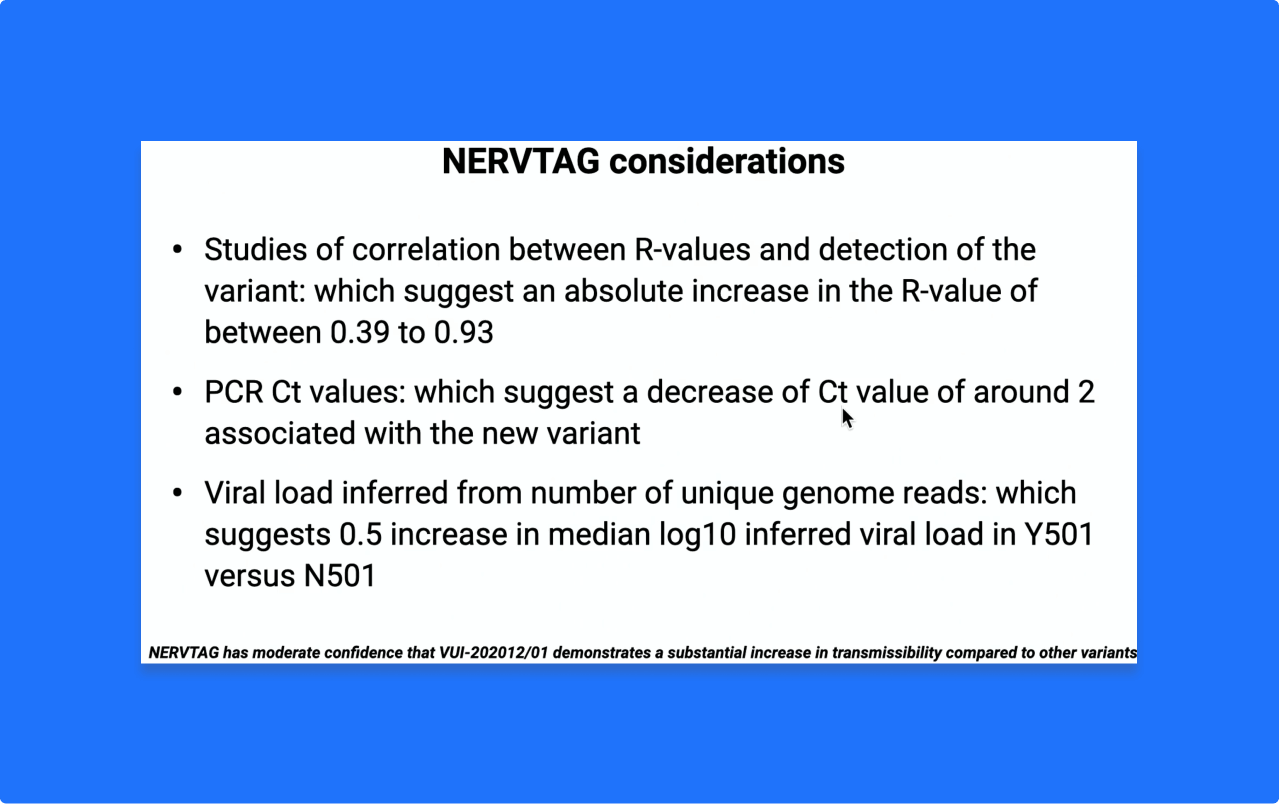New UK Coronavirus Variant Isn’t Even Worth a News Headline — Prof. Vincent Racaniello
Watch ➥ LIBRY | Rumble | BitChute | Brighteon | YouTube | Archive
Vincent Racaniello
Vincent R. Racaniello is a Higgins Professor in the Department of Microbiology and Immunology at Columbia University’s College of Physicians and Surgeons. He is a co-author of a textbook on virology, Principles of Virology.
Racaniello has received the Irma T. Hirschl, Searle Scholars, Eli Lilly, Julius Younger and NIH Merit awards. He has also been a Harvey Society Lecturer at Rockefeller University, the Hilleman Lecturer at the University of Chicago, and University Lecturer at Columbia University.
Notes
The original video is 26 minutes. I reduced it to 16 minutes. He references this paper on superspreader events and ‘NERVTAG meeting on SARS-CoV-2 variant under investigation VUI-202012/01’ meeting minutes. Follow Vincent Racaniello @profvrr
Transcript
Here’s a headline from the New York times this past weekend, the Corona virus is mutating. What does that mean for us?
Well, actually it probably doesn’t mean very much. I would say this is not a headline because viral genomes are always mutating. I think the headline writer needs to bone up on his or her virology.
We have seen 12,000 mutations and any two of those isolates differ by about 10 bases. So 10 out of 30,000 bases differ. And many of these have no consequence.
They’re actually just markers that we can use to do contact tracing, but they have no effect on the way the virus reproduces.
None of these mutations have led to a new strain. A strain is a variant that has a distinct biological property.
And I mean, in people, you can look in cells in the laboratory and find all kinds of differences, but what matters is in people, and as far as I’m concerned, none of the isolates so far have proven implications for human transmission or pathogenesis, including the latest variant isolated from the UK.
Coincidentally they’re neutral, they have no effect. And they seem to spread rapidly to a lot of people that alarms people, but in fact, it’s meaningless.
And one of the ways you can look at this is because we know that SARS-CoV-2 spreading when it happens, is actually done by a very few individuals.
December 21, 2020“I would say this is not a headline because viral genomes are always mutating. I think the headline writer needs to bone up on his or her virology.”
The rapid spread of a virus doesn’t have to be a consequence of novel genome mutations. We know that transmission of SARS-CoV-2 occurs mainly by super spreader events.
80% of transmissions are caused by 10% of infectious individuals. This has been studied in a number of countries. Here is a paper out of Hong Kong where they identified the main transmission events were super spreader events in weddings and churches and bars and restaurants, for example. And so here on the very left, on A, is an example of a super spreader event.
You have one individual B that went to a bar or a place with a lot of people, infected many others who then go on and infect many others and so on and so forth.
So you can see, I think from this, that if individual B in this diagram just happen to have a particular mutation is genome that say led to a spike amino acid change. He or she would spread it to a lot of other people who would spread it to a lot of other people.
And eventually it would be in a lot of people. And that’s why we get scared, when this, these kinds of events happen. But in fact, those changes can be neutral.
They may not be neutral, but you better have some good data to distinguish between them being neutral and not. And in my opinion, we do not have such data yet.
So I think anytime a particular amino acid change in the spike, which is what we’re seeing now for the UK variant, whenever they spread in the population, it’s simply a neutral spread, it’s by this founder effect combined with super spreader events.
Here are the spike protein amino acid changes – there are two different deletions. And then one, two, three, four, five, six, seven, single amino acid changes.
So that’s the well, the changes in the spike protein of this variant. And they go on further to say an increasing fraction in Southern England share several of these and a handful have been seen through imports in other countries.
And what I’m going to do now is show you where these are located. So remember the viral particle on the lower left is studded with spike glycoproteins that attach to the cell receptor.
They’re very important. We’re making antibodies against the spike in our vaccines to prevent infection. So the spike is biologically very important for the virus.
And that spike is a tremor of three polypeptide chains. And the structure of that is shown on the right two panels here. So we’re looking at down from the top at the spike tremor. So you can see from the schematic on the lower left, it’s a tremor. And if you look down from the top, you have one, two, three polypeptide chains.
And on the right, we’re looking from the side and here in green is ACE to the cell receptor. So in the light, gray is the part of the spike that binds ACE two. You can see here. Okay. So we’re going to look at these changes.
December 21, 2020“none of the isolates so far have proven implications for human transmission or pathogenesis, including the latest variant isolated from the UK.”
The changes in the spike in this variant are in different colors. As you can see down here, cyan, uh, orange or gold and blue.
Let’s take a look at where some of these changes are in the spike and what they, they might mean for its function.
So the blue are these single amino acid changes down here. There is one N501Y which is in gold right there. And then in cyan there, the deletions.
And if you look at the right-hand panel here where ACE two is binding to spike, you can see that one of these deletions is in the area of, uh, where the spike binds. So could change binding in some way, based on the evaluation of effects on virus, structure and function.
The most relevant of all these changes might be in N501Y. Asparagine to tyrosene at amino acid 501 of the spike. That’s in orange here and here that there’s three of them. So one, two, three, and you can see this is potentially impacting the spike.
And then they say, in positions contributing to potential spike surface variation. And there’s a deletion at Y145.
One of these cyan deletions is where some antibodies like one called 4AA8 bind. All right. So the others they think have no apparent, uh, interests.
So the ones they’re interested in is N501Y that could affect the binding of host receptors in antibodies. And then the deletion where one of them in particular could affect an antibody binding site. So here they say the other mutations, the blue ones.
So we’ve focused on cyan and gold. So the blue mutations, they say their effect on structure and function is less clear. And then they also say in another protein called or fate, there’s a early stop code on that could be relevant. This causes a deletion in the orphate protein.
And these have been seen before in other viruses, isolated from Singapore and also other countries. They may actually have, uh, a role to play in attenuation.

They may make the virus less virulent, which is not something you’re hearing at all. All you’re hearing is increased transmission.
And finally, they, they conclude as seen on many occasions before mutations are naturally expected for viruses and are most often simply neutral regional markers, useful for contact tracing.
As I’ve just told you, mutations are naturally expected for viruses. The mutations seen have rarely been effecting viral fitness and almost never affect clinical outcome, but the detailed effects of these mutations remain to be determined fully.
And that’s a reasonable statement in the past. We haven’t seen any such changes, make a big difference in transmission and disease in humans, but we should be aware of, of them going forward and make sure we study them.
And I think that’s perfectly fine, but what is not fine is all the hype now, which is about this strain, having higher transmission, which simply can’t be concluded so far.

There’s one other document I want to refer to. And again, the URL for it is down here, it’s from a committee called the new and emerging respiratory virus threats advisory group. So they had a meeting on the 20th of December, and here are the individuals in this meeting, some of whom are virologists epidemiologists and so forth.
And they have looked at the data on this variant and they’ve made some conclusions. So let me go through them with you, because I think this document is what’s scaring the world at the moment, and I don’t think that it is justified.
So I’m going to label these NERVTAG considerations. First within the UK, the variant is mostly in London, Southeast and East of England, but has been detected in various parts, but it’s mostly in those other areas. And a few have been reported internationally. One confirmed export from the UK to Australia.
I would say it’s already out because as they say here, a lot of other countries have lower sequencing capability than the UK and other countries. So it’s not easy to know that the variant is already there because you have to sequence isolates from people to know this.
Now here are the data which lead the committee to be somewhat worried. Uh, first of all, study is a correlation between our values and detection of the variant, uh, which suggests an absolute increase in the R value of between 0.3, 9.93. So our, of course, is the reproductive index.
The likelihood that an infected person on average will infect so many other people, right? So for SARS-CoV-2, we think it’s between two and three without mitigation, without doing any lockdown or any kind of masking or distancing and so forth. You can reduce the reproductive index obviously by interfering with transmission.
And so they’re saying that, um, in places where they see this variant, the, the R value is increasing. However, I would say, and again, this is my theme. You can’t use epidemiological data to prove a biological effect of a amino acid change in a virus.
You have to do experiments to do that. And that’s what they’re doing here. They say, there is an increase in the transmissibility. It must be because of the variant. Well, obviously that’s a flawed argument. That’s not how we do science.
That’s the other piece of data is the Ct value for the PCR, right? They take the swabs from patients. They do PCR, they get a Ct value, which is reflective of how many RNA copies are present in the sample. They say, there’s a decrease of Ct of around two associated with the new variant. Now, you know, the Ct values can go anywhere from 11 to 35 or so.

That’s the range, 11 being a lot of RNA and 35, very little and probably not infectious. So they’re saying in people in people infected with this variant we’re seeing the Ct value decrease. They have more RNA. So that must mean that the virus is reproducing better in them.
And they also cite viral load experiments. In other words, they take a nasal pharyngeal, swab extract, nucleic acid sequence. It, they have to convert it to DNA and amplify it. Then they sequence it and then you can calculate the number of RNA copies originally present. And they’re seeing more RNA copies.
So those are mainly the three pieces of data that they use to conclude that they have moderate confidence that this variant demonstrates a substantial increase in transmissibility compared to other variants.
So there are two adjectives in this sentence that I disagree with – moderate. I don’t agree, moderate confidence and substantial don’t agree. No, I think these are all circumstantial evidences that do not prove anything. You can imagine that our value could change by other things that are affecting transmission. And so you can’t conclude it’s the actual virus.
And as I said, if the virus is introduced into a population by founder effect, yeah, it’s neutral. It’s not going to have any effect on the R value. And the PCR is flawed in itself. You cannot use PCR to measure infectious virus. And that’s really what matters.
If you want to conclude that this virus is more transmissible, you need to measure infectious virus and I’ll get back to that later.
December 21, 2020“You can’t use epidemiological data to prove a biological effect of a amino acid change in a virus… That’s not how we do science.”
PCR doesn’t measure infectious virus and I can imagine for example, you have a variant that makes more smaller pieces of RNA in the infected cell. So the PCR shows a lowered Ct value, completely flawed argument to indicate that this is, leading to increase transmissibility.
But they then say, we don’t have enough data to draw any conclusions about the following. First, the mechanism of increased transmissibility, I would say we don’t yet know that there is increased transmissibility caused by these particular amino acid changes.
And so they say, for example, increased viral load. While you have to measure infectious virus, you can’t use PCR to do that age distribution disease severity. I think if anything, this variant is going to cause less severe disease because of the orphate deletion and then finally antigenic escape.
So, as I said earlier, the location of these amino acid changes, they’re using the wrong terminology as well. Uh, the location of the amino acid changes in the receptor binding the main of the spike raises the possibility that this is antigenically distinct and they’ve identified four re infections among 915 people with this variant.
But tell me how many re infections you see with the other variants as well. Is it not different? Uh, this, uh, is one antigenic site, one epitope of the spike, and there are about 20 B and T-cell epitopes on the spike.
I really don’t think that one change one epitope change is going to make much of a difference. And so they want more data on re-infection readmission and case fatality rates, which are apparently being collected more on the age distribution.
And then this one, this third one I think is important to look at in vitro data on the ability of convalescent sera, to neutralize the variant, to see if the amino acid changed in the anthropogenic site impacts the ability of convalescent sera to block infection, which would have of course, implications for vaccines. But I don’t think there are any, as I said, this is one out of many epitopes.
It is unlikely that it would make the virus unable to be neutralized say by antibodies that are induced by vaccination. And finally, they want to know if lateral flow assays to detect this variant. These would be antigen.
Assays would be compromised in any way. I think it’s depends on how you’ve set up the lateral flow assay. Of course, if you’re using more than one antibody, uh, you’re, you’re probably better off now.
Here’s what I think about this whole story. I would say I have low confidence that this variant demonstrates a substantial increase in transmissibility. I don’t see any evidence for that. I don’t see shedding evidence for increased transmission.
So if you think of viruses transmitting better, one possibility is that it’s more stable in the environment and that can be tested and other possibilities that the infected people shed more virus in respiratory secretions that can be tested.
So measure shedding and compared to people infected with the other variants that are circulating in these areas. Not everyone is infected with this variant, however, NERVTAG doesn’t have this on their list of experiments. And I said, PCR and sequencing cannot answer this question. Nucleic acid is not infectious virus.
December 21, 2020“I think if anything, this variant is going to cause less severe disease… they want more data on re-infection readmission and case fatality rates ”
This experiment is not going to be easy because you have to have a cohort of people infected with this variant and a variant that’s different predecessor, for example, and compare shedding by isolating virus. Uh, and you have to do that in cell culture and a BSL three laboratory of course. And the, the confounding problem is that when you take a nasal pharyngeal swab, for example, you get there slightly different volume from each person.
So you have to somehow normalize them when you do your infectivity calculation, not an easy thing to do. And you remember that not too long ago, another variant D614G arose and propagated throughout the world.
And similar, scary stories were told about that one increased transmissibility, but it was nothing was ever done in humans to really address that, including the experiments that I’m suggesting.
But in the end, I object to the use of epidemiological data to prove the biological properties of a virus.
You need to do experiments with the virus to prove that you have increased transmissibility or at least properties that are consistent with increased transmissibility. And that simply has not been done.
In my opinion, all the hype about this variant is unwarranted. Certainly we have to pay attention to it. We have to study it, but so far, I see no reason why this variant is any different from any others that have arisen. I think we should move on from the scary headlines.
More Resources:
- New Zealand Lockdown Prevented Only 1 Death from COVID19 — Dr Simon Thornley
- Prof. Sunetra Gupta — New Lockdown is a Terrible Mistake
- Public Health Prof. Raj Bhopal – Hopes that his Children Catch SARS-CoV-2
Source: ‘SARS-CoV-2 UK variant: Does it matter?”, https://www.youtube.com/watch?v=wC8ObD2W4Rk (Copyright Vincent Racaniello, December 21, 2020 – Permission Sought)
